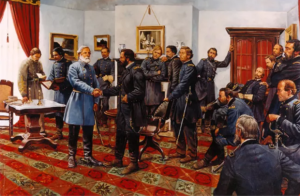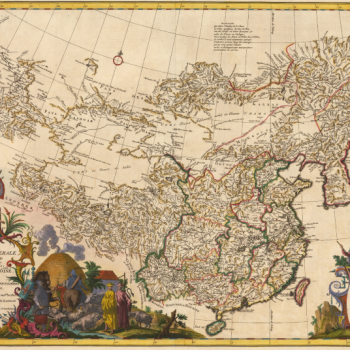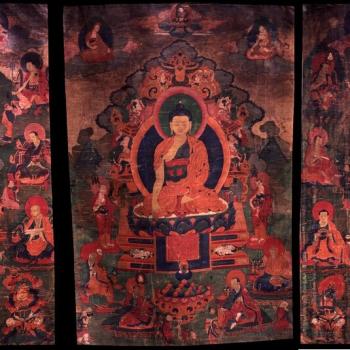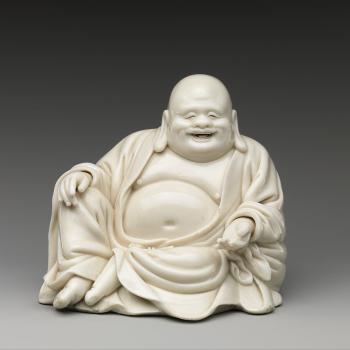
Despite the claim of Scott Morris Jr. in Confederate Poets that “[t]he poet-physician [Ticknor] never bothered to collect his verses in one volume … once they were published in magazines or journals they were forgotten” (Morris 16), there is reason to think that Ticknor viewed the “War Poems” as parts of a unified work and arranged them in something like their current order. They are prefaced by a dedication he himself wrote, “To the Women of the South … I consecrate these little poems” (“The Midnight Cross” ll. 1-2), which clearly suggests that he thought of them as a collection and made moves to distribute them as such. And Cutliff Ticknor’s decision to exclude several poems about the war and the Confederacy from the “War Poems” section and insert them elsewhere in her “corrected” 1911 edition only becomes intelligible if we assume that she was trying to keep true to the poet’s own intentions. Thus, we can assume that the placement of the poems follows Ticknor’s own design. This is significant because the poems that express millennialist ideals occur near the collection’s end, which in turn helps to make sense of what is surely one of the most bizarre choices in an already quite bizarre textual compendium; the decision to close out a sequence of poems focusing entirely on the Confederacy with a meditation on the death of King Arthur.
Lupack and Lupack, in King Arthur in America, briefly glance at this poem. However, unimpressed by Ticknor’s having dedicated it to Jefferson Davis, they relegate “Arthur the Great King” to a single sentence in a footnote, “Bridges is not the only American author to link the Arthurian legends and the Civil War. Frank O. Ticknor, a Georgia physician and poet, wrote a poem called ‘Arthur, the Great King,’ which was addressed to Jefferson Davis and made an analogy between Davis and King Arthur” (Lupack and Lupack 20, note 1). They swiftly dismiss the poem, without any discussion or even acknowledgement of its more interesting features. However, a quick look at their bibliography makes this oversight more understandable, for it reveals that they are using the version of the poem from the 1879 edition and thus are unaware that Ticknor reworked and expanded the poem considerably into the form it would take in the 1911 edition.
The changes are significant. The 1879 version is a straightforward elegy of the king. It is chiefly noticeable because it does compare Arthur to Christ—the running theme of our investigation—but it does so in a manner that is, for Ticknor, surprisingly restrained. He does not yet say that Arthur is Christ. Rather, he merely suggests, when taking comfort in the salvation Christ offers, that it would be no surprise if Arthur were Christ:
And were his face the Parian stone,
And were his smile King Arthur’s own,
Of all that met his kindling eyes,
Not one should marvel did he rise! [emphasis original] (“Arthur, the Great King” ll. 34-37)
Ticknor muses on Christ’s smile possibly being “King Arthur’s own” and uses this as a kind of proof that Christ’s rising from the dead is not surprising, through an obvious albeit clumsy glance at Arthur’s own deathlessness and future return. This bare hint is all that we get of an identification of Christ with Arthur or of Arthur’s return itself, and it is quietly passed over. For the most part, Ticknor here merely uses the promise of Christ’s salvation as a consolation for the collapse of Arthur’s earthly reign, both a more conventional theme and one appropriate to someone who had seen his own cause end in disappointment and failure.
But as Ticknor grew increasingly possessed by millennialist thinking, he could not let this somber message stand. Thus, he introduced several new elements into the text. The updated version of the poem now displays the marked influence of Tennyson’s own Arthurian works. Unlike Bridges, Ticknor feels no shame in admitting this. Not only does Ticknor directly address Tennyson in the new version, referring to him twice as “O Laureate” (at ll. 1 and 17) and calling his own poem “[a] leaf … for thy crown” (“Arthur the Great King” l. 1), but he even appends a lengthy footnote praising Tennyson and calling him the “Teacher” of Arthurian literature (“Arthur the Great King” 162). It is clear from the rest of the poem that what appealed to Ticknor in Tennyson was the same thing that had appealed to Bridges: a focus on Arthur’s return as a salvific, millennial event for all humanity. Like Bridges, he picked up on Tennyson’s hints that Arthur and Christ are the same being and, like Bridges, he chose to run with them. Now emboldened by millenarian fervor and the latent Arthurian Christology of Tennyson’s poetry, Ticknor transformed “Arthur the Great King” from an unremarkable poem of morning into something far more daring.
The poem now preoccupies itself with the question of Arthur’s return. A mere seven lines in, Ticknor announces his interest by stating, “Men murmur with the muffled breath, ‘Alive? or is he dead?’” (ll. 7-8). As soon as he takes up the question, he answers it affirmatively and hopefully. The next stanza paints an image of Arthur being ferried to Avalon before finally proclaiming, “The Great King never dies!” (l. 16). He repeats this point a few lines later—after yet another fawning proclamation of Tennyson’s genius—when he proclaims:
Not “Dead”—though earth’s last mountain be
Piled on the black depths of the sea,
And the last flame of lightning claim
To carve his “Memory”! (ll. 21-24)
Ticknor goes to extremes in order to emphasize how much he believes in Arthur’s continued survival. Arthur’s life will now outlast the “last mountain” and the “last flame.” It is particularly noteworthy that these lines associate Arthur, even indirectly, with apocalyptic events and the end of the world. There is the crumbling of mountains and the extinction of lightning, all linked by proximity to the idea of Arthur’s immortality. It does not yet make Arthur’s return a part of those events. But it does prepare the reader for that development to occur, as it soon will.
From here, Ticknor repeats most of the elegiac lines found in the 1879 edition. However, while the wording is often the same, there is no denying that they now have a more joyous and hopeful sense to them when read in the context of Arthur’s continued survival rather than his demise. In particular, the line about Christ’s smile perhaps being Arthur’s takes on a much greater significance in light of the above-noted apocalyptic associations Ticknor has affixed to Arthur’s return. No longer just a throw-away line in an otherwise mournful poem, it becomes another important foreshadowing of the movement that occurs at the poem’s close.
The ending itself is new. Just as he had done in “South in Memorial,” Ticknor artlessly tacks a handful of new lines (six in this instance) onto those that had previously ended his poem. The effect here is no less jarring. Whereas the poem had previously ended with Ticknor imagining being reunited in Heaven with a dead Confederate soldier “[w]ho waits me as the days expire / With Arthur’s soul of love and fire” (“Arthur, the Great King” ll. 53-54), the 1911 edition of the poem abruptly switches from this scene to a prophecy of Arthur’s coming return:
Doubt we then?
While sacrilege is charnel wise—
The arm that guilt in armor flies!
That Arthur—the great King shall rise!
That God’s Eternal Truth shall reign
Imperial o’er “His own” again! (“Arthur the Great King” ll. 79-84)
It has been evident throughout the poem that Ticknor believes in Arthur’s survival. Now he makes clear that he believes in the return itself as well. More importantly, the apocalyptic imagery and association with Christ that had marked his earlier mentions of Arthur’s return finally bear fruit. Here, Ticknor assures his readers that when “the great King shall rise,” what follows is that “God’s Eternal Truth shall reign / Imperial o’er “His own” again.” God shall rule over the world and “His own” people. His “Truth” that is “Eternal” shall at last be physically manifest on earth. Of course, these things can only happen in the Millennium, and these lines themselves seem like a direct allusion to description of the Millennium in Revelation 20:4, where Christ does indeed “reign Imperial” over “His own” alongside his saints. Thus, these lines themselves are Ticknor’s most direct description of the millennial kingdom and its establishment.
However, what is particularly striking is that Ticknor directly credits Arthur with establishing the Millennium. It is his rising that rings in God’s rule upon the earth and the eternal reign of justice. This places Arthur at the center of God’s apocalyptic plan and makes him the figure responsible for its fulfilment. This is a role, as I have stated before, exclusively reserved to Christ in Christian thought, something that the thoroughly devout Ticknor would have been as aware of as Bridges was. Thus, just as Bridges did when she spoke of finding herself “once more within this world, / On which the shades have gather’d into night / And mid the throng that wait the coming King,” Ticknor is actively casting King Arthur as Christ.
Poems such as “South in Memorial” demonstrate that Ticknor is both well-aware of and a believer in Christ’s role as the figure who rings in the Millennium. Thus, by giving this role to Arthur in this poem, he is suggesting that Arthur and Christare one and the same. This is supported by the hint of a shared identity in the “smile” line and the apocalyptic events already associated with Arthur’s immortality. It is also further demonstrated by the fact that Arthur is depicted not as returning by boat from Avalon but as rising from the dead: “the great King shall rise!” Poems like “South in Memorial” and “Under the Willows” reveal that Ticknor not only saw Christ himself as the chief millennial figure but that he viewed Christ’s rising from the dead as the key millennial act; by rising from the dead, Christ guides the world into the future age of perfection. Thus, for Ticknor to assign that resurrection and the global transformation that accompanies it to Arthur confirms that Arthur, in his mind, is Christ; they are the same person with the same salvific, apocalyptic destiny.
Ticknor’s footnote to the poem makes the identification even clearer. Almost the entire footnote is dedicated, as noted above, to showering Tennyson with a level of praise that quickly becomes sycophantic, with Ticknor exalting him over Charles Dickens and proclaiming, in words surely more suited to a great religious leader or humanitarian, “Many that have not heard his name have beholden his brightness in the lives of others, and profited ‘unaware’ by his ministration” (164). However, Ticknor concludes the footnote with some brief but important remarks on Arthur himself:
Of the “Great King” then, so dear to English hearts and English poetry, I will say only that he typifies all emotions that love righteousness and hate iniquity; that he embodies, also, a great Hope, the greatest which can cheer our Mortality or emphasize our Immortality—the undying Hope of a final and eternal Justice” (164).
Ticknor endeavors to spiritualize Arthur here and, without naming Christ directly, to associate Arthur with the Son of God. Arthur now “embodies … a great Hope” that “can cheer our Mortality or emphasize our Immortality.” Arthur himself has become the promise of life after death, which makes mortality bearable and assures living people of their own immortality of soul. In Christian doctrine, this hope is only available through Christ and He is the only guarantee of the soul’s immortality. Thus, when Ticknor instead turns Arthur into that guarantee and makes the hope of eternal life available through him, he must either be saying that Arthur is Christ or setting him up as an alternative to Christ. Given Christ’s importance to Ticknor, it cannot be the latter and thus it must be the former.
Furthermore, Ticknor says that Arthur represents “the undying Hope of a final and eternal Justice.” He is clearly referring to Arthur’s future return, as it would be hard to argue that Arthur’s earthly life offers much hope for justice being final and eternal. Therefore, by putting this final establishment of justice in the future, Ticknor ties it into the Millennium, because a justice that is both final and eternal can only come to earth in the Millennial Age. By making the returned Arthur the symbol of this millennialist hope, he is once again slotting Arthur into Christ’s millennial role and marking the king’s own return as synonymous with the birth of the millennial kingdom. Thus, by suggesting that Arthur is both the source of hope for salvation and the chief figure responsible for dawning of the Millennium, roles exclusively reserved to Christ in Christianity, Ticknor fully affirms the Christological implications of the poem itself and leaves no doubt that he believes Arthur and Christ to be one and the same.
The figure of Arthur that emerges from Ticknor’s Arthurian poem is much like the one seen in Bridges’s “Avilion,” the warlike and royal aspect of Christ whose return as “Once and Future King” will be identical with Christ’s own Second Coming. Ticknor, like Bridges, expects the coming of this composite millennial figure to specifically redress the suffering and injustices of the American Civil War. For while the Confederacy is never explicitly mentioned in “Arthur the Great King,” Ticknor’s other millennialist poems, which precede this one by only a few pages, assert that the Confederacy’s revival is a key part of God’s millennial program. If Arthur will be the one to fulfill God’s plan and ring in the Millennium, and the Confederacy’s restoration is the centerpiece of that millennial plan, then it follows that by inaugurating the Millennial Age, King Arthur will also be restoring the Confederacy. This image of an Arthur who is also Christ coming back to earth to revive the Confederacy as God’s millennial kingdom is a bizarre one, even more than Sallie Bridges’s corresponding vision from the Union side. Yet, given that the poems which provide its component parts are all clustered together at the very end of a collection that Ticknor himself seemed to view as an organic whole, we must conclude that this strange notion is indeed what Ticknor wanted readers of this poetry collection to walk away with.
Ultimately, Ticknor’s vision, despite having been dreamed up independently of Bridges’s own, parallels hers in all significant respects. Here too are Christ and Arthur revealed to be the same person. Here too is Arthur credited with establishing the Millennial Age. The Civil War is again made the main precipitating event of the Millennium, with Christ-Arthur coming back to earth specifically to undo the devastation wrought by it. Ticknor and Bridges came from different sides of the conflict and thus would have had vastly different ideas about what undoing that destruction would look like, but they were in complete agreement about the outlines of the apocalyptic program and its startling implications.
For both Bridges and Ticknor, King Arthur and Jesus Christ where the same person—on a spiritual level if not a historical one—and thus all the prophecies of Arthur’s return and Christ’s Second Coming referred to a single future event. For both, the Civil War was the apocalyptic prelude to the event; the conflict of Union and Confederacy had a cosmic significance and would bring about Christ-Arthur’s return and the final, utopian end of history in the Millennial Age. It was a strikingly original idea, all the more so given that it came from two highly unoriginal poets. It was also a remarkable coincidence, since Bridges and Ticknor were unaware of each other, held contrasting allegiances, and differed so markedly in every respect, with only the turmoil of the Civil War and a debt to Tennyson to unite them. But still, it happened, and out of that internecine American strife, a shared vision of an Arthurian-American apocalypse emerged that was highly eccentric, decidedly unorthodox, and undeniably bizarre, but also incredibly innovative and unquestionably transformative.
There of course were antecedents. The widespread reach of American nationalist millennialism explains why both Bridges and Ticknor would be so quick to place their own country at the center of the Christian apocalyptic scheme. Indeed, their example demonstrates that nationalist millennialism was nowhere near as rigid and unchanging as it is often portrayed. In addition, the similarity of their ideas weakens attempts, such as that recently carried out by John Matsui in Millenarian Dreams and Racial Nightmares, to portray Union and Confederate millennialist ideas as fundamentally distinct. Matsui’s claim that “postmillenarian ideology came to dominate the northern states during the war years” (Matsui 5) but “[t]he formation of the southern Confederacy was a consciously premillenarian revolution” (48) looks a little more questionable when the poems of Bridges and Ticknor are brought to mind. However, Bridges and Ticknor also proved far more daring in their formulations of American nationalist millennialism than their contemporaries, willingly reinventing the idea by importing their own hopes and beliefs as well as their uniquely Arthurian interests.
There was also the Tennysonian influence. Both Bridges and Ticknor expressed their debt to Tennyson, even if Bridges was more grudging in her admiration. They were both far more insightful readers of his work than the quality of their own poetry would suggest and keenly recognized his suggestions of a spiritual equivalence between Arthur and Christ and of Arthur’s role in the coming Millennium. In this sense, Ticknor revealed more than he knew when he cast Tennyson into a kind of religious role as “Teacher” and minister—recall his reference to Tennyson’s “ministrations”—given that Tennyson did indeed alter and transform the religious beliefs of these two highly devout poets. Still, while their poems are otherwise filled with a fervent but highly conventional Christianity, both poets ventured further into heterodoxy than the decidedly unorthodox Tennyson was ever willing to openly do.
Once they fully embraced the conviction that Arthur was Christ—and thus, it bears noting, God Himself—applying his salvific, millennial mission to America’s civil conflict might not have seemed like such a big step to make, given the tenor of the times. And make it they did, with an originality and boldness unmatched by their contemporaries. Even if Bridges’s and Ticknor’s shared Arthurian millennialist vision never reached much beyond them, that they both came up with it independently demonstrates that there was a latent potential in the figure of Arthur—at least as reimagined by Tennyson—to fully take on the trappings of Christ and even to inherit the global scope of His messianic mission.
In truth, the latent potential had always been there. Ticknor’s claim that Arthur “embodies … the undying Hope of a final and eternal Justice” is, in one sense, bad literary criticism. It would hard to say that there is anything final and eternal in the justice of Geoffrey’s world-conqueror who flares briefly across the pages of history or in that of Malory’s tragic, decrepit king slouching ever closer to his realm’s downfall. But in another sense, Ticknor is correct. The return myth has always been about the hope for the final establishment of universal justice and a righting of the wrongs of history. It makes a single man, Arthur, the vessel of that hope, in direct contradistinction to the other single man whom Christianity says is the only legitimate source of hope for the future. In the Middle Ages, this necessitated the use of the Last World Emperor narrative as a kind of release value, allowing Arthur to have his return while also keeping him from competing with or displacing Christ as destined world-savior. The Last Emperor concept placed Arthur in a role where he could save the world—at least the Christian world—in the future and contribute to the coming of the millennial kingdom, but safely kept him in a subordinate role to Christ.
However, the Last Emperor narrative eventually fell to the wayside, at least in the English-speaking world. With no other widely accepted belief that could contain the potentially heterodox implications of Arthur’s future return, it was probably inevitable that those implications would find a less restrictive outlet of expression. Fortuitously, that outlet came in the form of Alfred Tennyson, the man who would become Poet Laureate of England and thus wield incredible influence in Britain and abroad. In many respects, it is his Arthur—unerringly noble, unswervingly righteous, and decidedly Christlike—who has become our Arthur, even if other authors before or since have done more to shape the popular narrative of the king’s life. Thus, Tennyson’s vision of the return as an analogue of Christ’s Second Coming is still with us, undergirding our own ideas about Arthur’s reappearance, however much we may fail to recognize it. In his own time, the Christ-Arthur identification he pioneered was most fully developed by Bridges and Ticknor. Even if their own formulations are little more than curious asides in the history of both Arthurian and American literature, the ideas that inspired them are still a part of our own thinking about Arthur, not always visible, but always just below the surface, waiting to be discovered again.
A Note on Sources
There is a slight difference in how the title of the poem, “Arthur the Great King” is punctuated in the 1879 and 1911 editions of Ticknor’s work. In the 1879 volume, it is “Arthur, the Great King” with a comma. The 1911 volume omits the comma and that form of the title is the one I have chosen to use throughout. However, where I have directly quoted the version of the poem from the 1879 volume, however, I have cited it as “Arthur, the Great King” with the comma, while citing the later form of the poem found in the 1911 edition as “Arthur the Great King” without the comma. That the Lupacks use “Arthur, the Great King” exclusively in King Arthur in America is the first indication that they are using the 1879 version alone and are completely unaware of the 1911 one. When citing Ticknor’s footnote, I have also used “Arthur the Great King” but replaced the line numbers with a page number.
As before, the two editions of Ticknor’s poetry cited above are:
The Poems of Francis Orray Ticknor, edited by Michelle Cutliff Ticknor. New York: Neale Publishing Company, 1911. https://hdl.handle.net/2027/mdp.39015063973849
The Poems of Frank O. Ticknor, M.D., edited by Kate Mason Rowland. Philadelphia: J. Lippincott and Co., 1879. https://hdl.handle.net/2027/uc1.$b274732
The other sources cited above are:
Lupack, Alan and Lupack, Barbara Tepa. King Arthur in America. Cambridge: D. S. Brewer, 1999.
Matsui, John H. Millenarian Dreams and Racial Nightmares: The American Civil War as an Apocalyptic Conflict. Baton Rouge: Louisiana State University Press, 2021.
Morris, Jr., Scott. Confederate Poets: Physician and Priest. Macon: Southern Press, Inc., 1963. https://hdl.handle.net/2027/nnc1.1002282194












